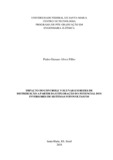| dc.creator | Alves Filho, Pedro Genaro | |
| dc.date.accessioned | 2019-02-25T20:22:13Z | |
| dc.date.available | 2019-02-25T20:22:13Z | |
| dc.date.issued | 2018-08-29 | |
| dc.identifier.uri | http://repositorio.ufsm.br/handle/1/15749 | |
| dc.description.abstract | The presence of Distributed Generation is a reality in the Brazilian electric sector, with the prospect that increasingly the participation of these sources contributes to the energy matrix of our country. Faced with this imminent growth, it is necessary to study the impacts caused by the injection of active power in distribution networks and how to mitigate these effects. The solution to the quest for greater system stability may be in managing the reactive power that some of the distributed generations are able to offer. This work presents a methodology to evaluate the impacts caused in the voltage, and how the fluctuation of this magnitude changes the behavior of the traditional voltage regulators in the system under study, due to the different operating conditions of the solar inverter when it operates in the fixed mode of factor of power unit and within the limits of the ABNT NBR 16149 Brazilian standard. It is also evaluated the use of a solar inverter capable of supporting the grid voltage through the management of reactive energy, a resource that is not yet consented to be used in Brazil's distribution networks. The developed methodology was validated in an IEEE 123 nodes test system, which represents a distribution feeder, with some proposed modifications. In view of the analysis of the system responses to the different operating modes of the inverter, it was possible to indicate the method that causes the least impact on the voltage profile of the evaluated system, and consequently indicate which causes the least number of voltage regulator maneuvers, taking as reference the scenario in which the feeder under study does not have distributed generations. | eng |
| dc.language | por | por |
| dc.publisher | Universidade Federal de Santa Maria | por |
| dc.rights | Attribution-NonCommercial-NoDerivatives 4.0 International | * |
| dc.rights.uri | http://creativecommons.org/licenses/by-nc-nd/4.0/ | * |
| dc.subject | Geração distribuída | por |
| dc.subject | Controle Volt-VAr | por |
| dc.subject | Inversor solar | por |
| dc.subject | ABNT NBR 16149 | por |
| dc.subject | Reguladores de tensão da distribuição | por |
| dc.subject | Distributed generation | eng |
| dc.subject | Volt-VAr control | eng |
| dc.subject | Solar inverter | eng |
| dc.subject | ABNT NBR 16149 standard | eng |
| dc.subject | Distribution voltage regulators | eng |
| dc.title | Impacto do controle Volt/VAr em redes de distribuição a partir da exploração do potencial dos inversores de sistemas fotovoltaicos | por |
| dc.title.alternative | Impact of Volt / VAr control in distribution networks from the exploration of the solar inverters potential of distributed generations | eng |
| dc.type | Dissertação | por |
| dc.description.resumo | A presença da Geração Distribuída é uma realidade no setor elétrico brasileiro, havendo a perspectiva de que cada vez mais a participação dessas fontes contribua para matriz energética de nosso país. Diante desse eminente crescimento, faz-se necessário estudos dos impactos causados pela injeção de potência ativa nas redes de distribuição e como mitigar estes efeitos. A solução na busca por uma maior estabilidade do sistema pode estar no gerenciamento da potência reativa que algumas das gerações distribuídas são capazes de ofertar. Este trabalho apresenta uma metodologia para avaliar os impactos causados na tensão e como a flutuação desta grandeza altera o comportamento dos tradicionais reguladores de tensão existentes no sistema em estudo devido as diferentes condições de operação dos inversores dos sistemas fotovoltaicos, quando estes operam no modo fixo de fator de potência unitário e nos limites da norma brasileira ABNT NBR 16149. Também é avaliado o uso do inversor de sistema fotovoltaico capaz de dar suporte à tensão da rede através do gerenciamento de energia reativa, recurso este que ainda não tem o uso consentido nas redes de distribuição do Brasil. A metodologia desenvolvida foi validada em um sistema de testes IEEE 123 nós, o qual representa um alimentador da distribuição, com algumas modificações propostas. Diante da análise das respostas do sistema para os diferentes modos operativos do inversor, foi possível apontar o método que causa o menor impacto no perfil de tensão do sistema avaliado, e consequentemente indicar qual o que provoca o menor número de manobras dos reguladores de tensão, tomando como referência o cenário em que o alimentador em estudo não possui gerações distribuídas. | por |
| dc.contributor.advisor1 | Canha, Luciane Neves | |
| dc.contributor.advisor1Lattes | http://lattes.cnpq.br/6991878627141193 | por |
| dc.contributor.referee1 | Pereira, Paulo Ricardo da Silva | |
| dc.contributor.referee1Lattes | http://lattes.cnpq.br/1997755245309923 | por |
| dc.contributor.referee2 | Bernardon, Daniel Pinheiro | |
| dc.contributor.referee2Lattes | http://lattes.cnpq.br/6004612278397270 | por |
| dc.creator.Lattes | http://lattes.cnpq.br/2428148883734929 | por |
| dc.publisher.country | Brasil | por |
| dc.publisher.department | Engenharia Elétrica | por |
| dc.publisher.initials | UFSM | por |
| dc.publisher.program | Programa de Pós-Graduação em Engenharia Elétrica | por |
| dc.subject.cnpq | CNPQ::ENGENHARIAS::ENGENHARIA ELETRICA | por |
| dc.publisher.unidade | Centro de Tecnologia | por |



